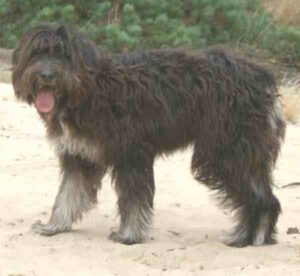The Portuguese Sheepdog is a medium-sized breed of dog of the herding dog type. It is one of the indigenous regional dogs of Portugal. The breed is also known by some other names such as Cão da Serra de Aires, Portuguese Shepherd Dog and Serra de Aires Mountain dog.
The Portuguese name refers to Serra de Aires, a mountain near Montforte in the Alentejo region. The breed is nicknamed cão macaco (‘macaque dog’, ‘monkey dog’) for its furry face and lively attitude.
Ancestors of the modern breed were traditionally used for herding cows, sheep, goats, horses and even pigs in the Serra de Aires and in the Alentejo.
As with other breeds who came from undocumented, working dog origins, “… data is rare, or does not exist … most guardian and herding breeds do not have records before 1900”.
The dog is recognizable as one of the old-fashioned types of European sheepdogs, believed to be closely related to the Pyrenean and Catalan Sheepdogs. It is also believed to be descended from Briards imported into Portugal in the early 1900s by the Conde de Castro Guimarães from Cascais, and crossed with the Pyrenean Sheepdog.
The landscape of the Serra de Aires is barren and harsh and it has been noted that the breed would have had a difficult time adapting to the climate there.
The first breed standard was written by Antonio Cabral and Felipe Morgado Romeiros and was accepted by the Portuguese Kennel Club. The breed was recognized internationally in 1996 by the Fédération Cynologique Internationale, under the name Portuguese Sheepdog in English.
The breed has become a popular companion and pet in Europe, and has been exported to many other countries. It is recognized by the United Kennel Club in the United States, in it’s herding group as of 2006.
It is also recognized and listed under its original name or various translations by minor kennel clubs, specialty clubs, and Internet dog registry businesses, and is promoted as a rare breed for those seeking an unusual pet.[1]
Portuguese Sheepdog Characteristics
The Portuguese Sheepdog dog is a medium-sized breed. It’s body is long and has a long coat without an undercoat, of medium thickness and described as having a ‘goat like’ texture.
The lack of an undercoat makes the dog less resistant to extreme weather as a working dog. Typical coat colors include chestnut, grey, yellow, wolf grey, fawn and black, with tan marks. White hairs may be mixed in with the coat, but there should be no large white patches.
Tail of the Portuguese Sheepdog should be long, and a natural bobtail is a disqualification under the breed standard. The tail should never be docked. They have drop ears which are set high and close to the head.
Average height of the mature dog is between 16 and 22 inches at the withers. And their average live body weight is between 17 and 27 kg.

Temperament
The Portuguese Sheepdog is one of the most devoted and clever of the sheepdogs. It is a high-spirited, happy dog that is eager to work. It is very loyal and bonds with it’s own people.
The breed has a lively, above-average intelligence and learns quickly and easily. But can be dominant and will be stubborn if it senses it’s owners are not as strong minded as itself.
The Portuguese Sheepdogs mix well with other dogs, although some males may try to dominate other males. They can live happily alongside other pets provided they have been properly socialized.
They are generally patient with children but the males in particular can be possessive of their territory. They are reserved with strangers and make good watchdog. They tend to like only the livestock it care for and it’s master.
Lifespan
Average lifespan of the Portuguese Sheepdog is between 12 and 13 years.
Feeding
How much a mature dog eats depends on it’s size, age, build, metabolism and activity level. Dogs are individuals, just like people, and they don’t all need the same amount of food.
The Portuguese Sheepdog is a medium-sized breed with moderate exercise needs. So, it’s diet should be formulated for a medium-sized breed with average exercise needs. You can consult with a vet in your area for better feeding recommendations.
Caring
Taking good care of the animals is very important for raising Portuguese Sheepdogs. They have extreme stamina. If it gets enough exercise, including a daily, long walk, it will be calm in the house. This breed does very well in agility.
The breed is not recommended for apartment life. Assuming it gets enough exercise it will be calm indoors. As a working dog with a need for exercise, it prefers living outdoors, but does enjoy an occasional visit in the home.
Check the all-weather coat regularly for tangles but do not brush the coat too much, as it will affect the texture and the rough look. Trim any excess hairs between the pads of the feet. This breed should be shampooed only when necessary.
Health
The Portuguese Sheepdogs are generally healthy. But like all other dog breeds, they are also prone to certain health conditions.
Their common health problems include ehrlichiosis transmitted by ticks and abdominal tumors. Always try to keep good contact with a vet in your area.
| Breed Name | Portuguese Sheepdog |
| Other Names | Also known as Cão da Serra de Aires, Portuguese Shepherd Dog and Serra de Aires Mountain dog |
| Breed Size | Medium |
| Height | Between 16 and 22 inches at the withers |
| Weight | Between 17 and 27 kg |
| Good as pets | Yes |
| Climate Tolerance | All climates |
| Color | Chestnut, grey, yellow, wolf grey, fawn and black, with tan marks |
| Lifespan | Between 12 and 13 years |
| Good for children | Yes |
| Rarity | Common |
| Country of Origin | Portugal |






